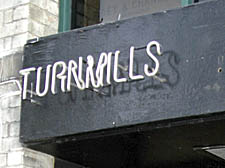|
|
 |
| |
 Turnmill building ‘has industrial aesthetic’ Turnmill building ‘has industrial aesthetic’ |
Demolition threat to former nightclubCONSERVATION campaigners were last night preparing to do battle with a developer over plans to demolish Farringdon’s famous Turnmill building.
Derwent London wants to flatten the former nightclub, once a 19th-century stables building, and replace it with a seven-storey glass office, café and shops complex.
But English Heritage, the Victorian Society and Save Britain’s Heritage, which is based around the corner from the Clerkenwell Road building, have lodged strong objections.
In papers due to be presented to an Islington Council south area planning committee last night (Thursday), Town Hall officials recommended approval of plans for a building 10 metres taller than the existing one.
Derwent London claims keeping the existing building is “not financially viable”. Its units “are complex with varying types of aesthetics, condition, layout and appearance, specification and size”, according to the firm.
Although the building is not listed, it is within a conservation area and heritage groups believe it is an essential link to Farringdon’s past.
In a letter of objection, English Heritage’s historic buildings and areas advisor Dorian Crone said: “Although not architecturally sophisticated, the building has a robust industrial aesthetic quality that reflects the Victorian transformation of Clerkenwell from an area of small domestic buildings and workshops to one of larger-scale warehouses and factories.”
According to English Heritage, the Turnmill building, opened in 1886, was used as a warehouse and stables for the Great Northern Railway Company and later a warehouse for Booth’s Gin Distillery.
Mr Crone added: “The building possesses historic and aesthetic value, and is... of considerable significance.”
William Palin, secretary of Save Britain’s Heritage, said: “It may not be as architecturally stunning as the Sessions House across the road but it’s a really good-quality commercial and industrial building. It’s a good example of an old building that’s been successfully re-used in a number of ways.
“The new plans move away from complexity and interest and towards uniformity and blandness. It’s the erosion of the conservation area and the distinctive quality of Clerkenwell. It’s a building close to our hearts.”
English Heritage has noted the similarities with the battle to save Smithfield Market, which was won following a long public inquiry in May last year.
Derwent London declined to comment. |
 |
|
|
 |
Your comments:
NO one "saved Smithfield Market" The Market has been proyected by law. English Heritage simply interfered in a project which was designed to help the Market long term.
P. Martinelli
|
| |
| |
|
 |
|